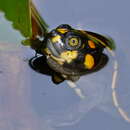Lifespan, longevity, and ageing
المقدمة من AnAge articles
Observations: There are no detailed studies of longevity in this species. They appear to live at least 20 years. Anecdotal evidence suggests these animals can live up to 70 years (http://www.zoo.org/), which is plausible even if unverified.
- ترخيص
- cc-by-3.0
- حقوق النشر
- Joao Pedro de Magalhaes
Biology
(
الإنجليزية
)
المقدمة من Arkive
Male yellow-headed sideneck turtles court females by nipping at their feet and tails. During the evening, two weeks after mating (4), the female lays an average of 20-30 eggs in a fairly shallow nest (7), and these incubate under the heat of the sun for two months. The sex of the hatchlings is determined by the temperature at which they incubate. Eggs incubated below 32 ºC will hatch as males, and those incubated above 32 ºC will be females (8). Just a few days after hatching, the young turtles begin to forage for food alone. Food includes vegetable matter, grasses, fruits, leaves, carrion and molluscs. They are at risk of predation by humans, birds, snakes, large fish, frogs and mammals (4).
The yellow-headed sideneck turtle is diurnal and is most active in mid-morning and the afternoon. Groups of turtles can be seen basking in the sun on logs or stones in the middle of rivers, and they may also lie on the shore. As ectothermic (cold-blooded) animals, this behaviour functions to warm their bodies (2).
Conservation
(
الإنجليزية
)
المقدمة من Arkive
As the main consumers of yellow-headed sideneck turtles, the indigenous Yekuana Indians are now trying to hunt the turtles sustainably. They have implemented a conservation program for the 12 main nesting sites of the turtle along the de Ninchare River and these areas are now protected from poachers by armed guards. Other conservation initiatives include rescuing clutches that are at risk of being flooded by rising rivers, as well as rearing yellow-headed sidenecked turtles commercially (2).
Description
(
الإنجليزية
)
المقدمة من Arkive
The yellow-headed sideneck turtle gets its name from yellow spots on the olive green to brown head, which are most obvious in young turtles, and fade to almost nothing in females, but remain present in males throughout life. The carapace is domed with a raised ridge in the centre, known as a keel. The plastron is yellow and sometimes has dark blotches. The head is long with a distinct snout, and there is a barb on the chin. This turtle belongs in the family Pelomedusidae, which contains the side-necked turtles, and has a long neck which can be withdrawn horizontally within the margins of the shell, leaving it partly exposed, rather than retracting it in a vertical 'S' bend as in most other turtles (4) (5).
Habitat
(
الإنجليزية
)
المقدمة من Arkive
The yellow-headed sideneck turtle is found in calm waters and will occupy flooded forests, swamps and lagoons during high water and riverbeds in the dry season (2).
Range
(
الإنجليزية
)
المقدمة من Arkive
This turtle is found in the Amazon and Orinoco river systems in northern South America, including Venezuela, eastern Colombia, eastern Ecuador, northeastern Peru, the Guianas, Brazil, and northern Bolivia (6).
Status
(
الإنجليزية
)
المقدمة من Arkive
The yellow-headed sideneck turtle is classified as Vulnerable (VU) on the IUCN Red List 2007 (1) and is listed on Appendix II of CITES (3).
Threats
(
الإنجليزية
)
المقدمة من Arkive
The greatest threat to this species is hunting by indigenous people known as Yekuana Indians, as they previously regularly consumed the meat and eggs of this species. The number of poachers is thought to have increased in recent years, as demand for both turtle eggs and turtle meat increases (9).
Climate change can potentially threaten turtle species as the sex of offspring is determined by the temperature at which they are incubated. Should the temperature rise two degrees Celsius, the ratio of males to females could be severely skewed, and a rapid rise of four degrees Celsius could possibly eliminate males altogether. Turtles are seen as indicator species that can reveal the effects of climate change on the natural world (10).

